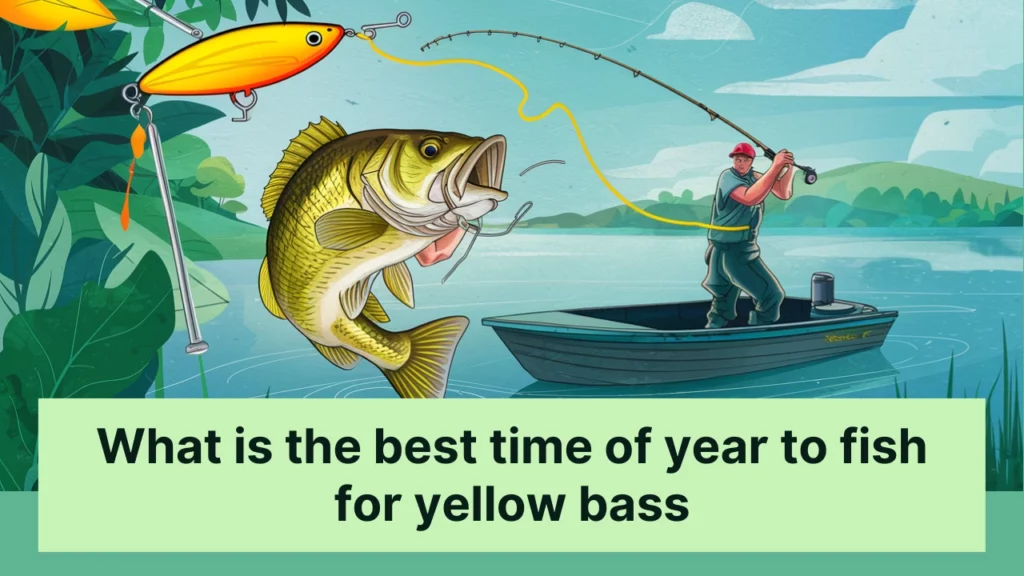What we know about Yellow Bass:
The Yellow Bass, scientifically known as Morone Mississippiensis, is a fish with 5-7 rows of stripes on its yellow body. It has a dorsal fin that is split into two parts.
The first part has nine spines, while the second part has 1 spine and 12 rays.
Unlike its white cousin, the Yellow Bass has around 10 anal rays and lacks a small patch of teeth on its tongue.
The upper part of a Yellow Bass is a dark olive green color, while its entire body is mostly shiny yellow.
Understanding Yellow Bass Behavior:
Yellow bass are like shiny superheroes in the water, wearing yellow and gold outfits with cool stripes.
They love hanging out in calm, slow waters where there are lots of tiny creatures to eat.
You can find them in deep spots close to where they lay their eggs, like in the Mississippi River area, east Texas, and parts of Georgia.
To catch these special fish, it’s important to know what they like to eat and how they behave in different seasons.
What Yellow Bass Like to Eat:
Yellow bass, belonging to the Moronidae family, start by eating tiny creatures like invertebrates and water bugs when they are young.
As they grow up, they switch to mainly eating small fish and some shellfish.
They are smart about what they eat, changing their feeding habits based on what’s around them.
Knowing what they like to eat is key to catching them while fishing, matching your bait and techniques to their natural food for the best chance of success.
Best Season to Catch Yellow Bass:

Spring Spawn: During spring, yellow bass are most active in shallow waters as they prepare for spawning.
Live bait such as nightcrawlers and minnows are highly effective during this period. Target shallow flats and areas with sandy bottoms where yellow bass gather to spawn.
Summer Feeding Frenzy: As temperatures rise, yellow bass move to deeper waters in search of food.
Mimicking natural prey with artificial lures like crappie jigs and beetle spins can yield great results.
Focus on drop shot rigs and targeted casting near structures and chokepoints.
Fall and Winter Challenges: In the cooler months, yellow bass become more sluggish and conserve energy.
Live bait remains effective, but adjusting presentation and depth is crucial.
Utilize depth finders to locate fish in deeper waters and adapt bait choices accordingly.
Best bait/lures for Yellow Bass fishing:
Live Bait:
Nightcrawlers and Red Worms:
Natural offerings that appeal to yellow bass’s feeding instincts, especially during spawning season.
Minnows:
Versatile bait that attracts yellow bass as well as other species like crappie and largemouth bass.
Artificial Lures:
Crappie Jigs:
Mimic natural prey and can be customized to match prevailing conditions.
Use vibrant colors in murky waters and natural tones in clear water.
Beetle Spins:
Effective in low-light conditions, offering visibility and enticing yellow bass to strike.
Jigging Spoons:
Ideal for deeper waters, especially when tipped with a small piece of worm for added scent attraction.
Expert Tips for Success:
Patience and Observation:
Take time to observe yellow bass behavior, preferred habitats, and feeding patterns. Adapt bait choices and techniques accordingly.
Adaptability:
Be flexible in switching between live bait and artificial lures based on seasonal variations and prevailing conditions.
Depth and Presentation:
Utilize depth finders to locate fish at optimal depths. adjust bait presentation to match the depth and movement of yellow bass, increasing your chances of a successful catch.
Conclusion:
Mastering yellow bass fishing requires a combination of knowledge, experience, and adaptability.
By understanding seasonal variations, utilizing the right bait and techniques, and staying observant on the water, anglers can unlock the secrets of yellow bass fishing and enjoy the thrill of a successful catch.
Embrace the challenges, hone your skills, and immerse yourself in the timeless pursuit of mastering yellow bass fishing.



